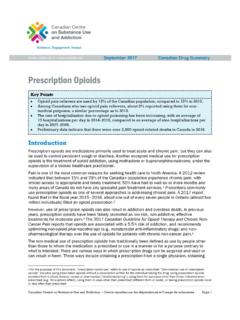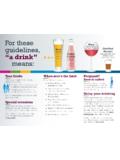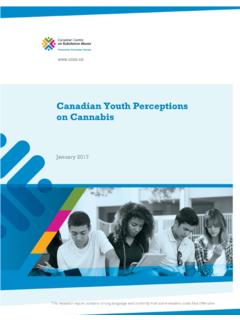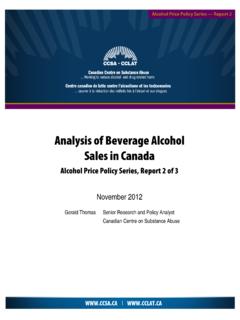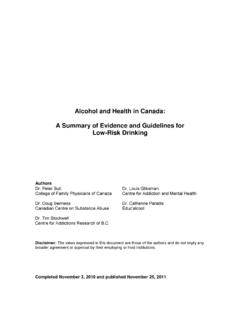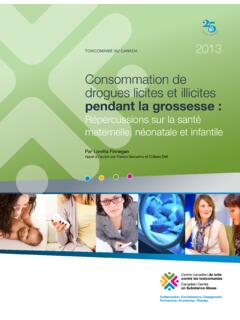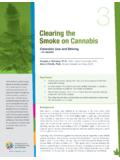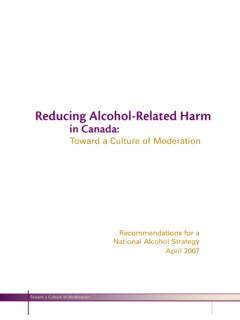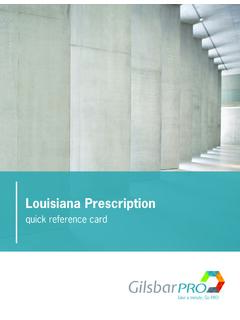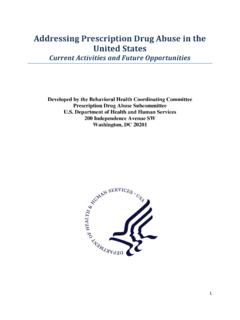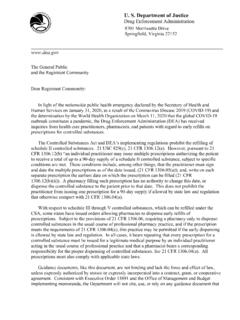Transcription of Prescription Opioids (Canadian Drug Summary)
1 July 2020 Canadian Drug Summary Canadian Centre on Substance Use and Addiction Centre canadien sur les d pendances et l usage de substances Page 1 Prescription Opioids Introduction Prescription Opioids are medications primarily used to treat acute and chronic pain, but they can also be used to control persistent cough or diarrhea. Another accepted medical use for Prescription Opioids is for the treatment of opioid use disorder, using methadone or buprenorphine-naloxone, under the supervision of a trained healthcare practitioner. Pain is one of the most common reasons for seeking health care in North America. Recent estimates indicate that about one in five Canadians experience chronic pain,1 and many have limited access to appropriate and timely treatment: 50% have had to wait six months or more and many regions in Canada do not have any specialist pain treatment Prescribers commonly use Prescription Opioids as one of several approaches to addressing chronic pain.
2 A 2017 report found that in the fiscal year 2015 2016, about one out of every seven people in Ontario (almost two million individuals) filled an opioid In Canada in 2018, almost one in eight people were prescribed From 2016 to 2017, the total quantity of Opioids dispensed decreased by more than 10% and the number of prescriptions for Opioids fell by more than 400,000, the first decline seen since ,5 However, the use of Prescription Opioids can also result in addiction and overdose death. In previous years, Prescription Opioids have been falsely promoted as low-risk, non-addictive, effective treatments for moderate The 2017 Canadian Guideline for Opioid Therapy and Chronic Non-Cancer Pain reports that Opioids are associated with a risk of addiction, and recommends optimizing non-opioid pharmacotherapy ( , nonsteroidal anti-inflammatory drugs) and non-pharmacological therapy over the use of Opioids for patients with chronic non-cancer Key Points In 2017, opioid pain relievers were used by an estimated of the Canadian population, compared to 13% in 2015.
3 A greater number of Indigenous peoples aged 15 and older who live off-reserve reported past-year use of opioid medication, compared to the general population. Among Canadians who used opioid pain relievers in 2017, about 3% reported using them for non-medical purposes, a similar percentage as in 2015. The rate of hospitalization due to opioid poisoning has increased, with an average of 17 hospitalizations per day in Canada in 2017. There were at least 15,393 opioid-related deaths in Canada between January 2016 and December 2019, with the highest number of deaths occurring in 2018. The rate of emergency department visits for opioid poisoning has doubled for younger adults aged 25 44, an increase larger than for any other age group. Canadian Drug Summary: Prescription Opioids Canadian Centre on Substance Use and Addiction Centre canadien sur les d pendances et l usage de substances Page 2 The non-medical use of Prescription opioidsA has traditionally been defined as use by people other than those to whom the medication is prescribed or use in a manner or for a purpose other than what is intended.
4 There are various ways in which Prescription drugs can be acquired and used or can result in harm. These ways include obtaining a Prescription from a single physician, obtaining prescriptions from multiple physicians without informing them of other prescriptions in the past 30 days ( double doctoring or doctor shopping ), Prescription fraud and forgery, theft, street drug markets and Internet purchases. A Canadian study found that 37% of opioid-dependent patients admitted to the Centre for Addiction and Mental Health in Toronto reported receiving Opioids solely from physician prescriptions, compared to 26% of patients who received Opioids from both a Prescription and the street, and 21% from the Opioids are commonly referred to as pain killers or narcotics and have a variety of generic, trade and street names. Table 1 lists examples of Prescription Opioids currently marketed in Canada. However, Prescription Opioids not marketed in Canada might be diverted into the country.
5 Prescription Opioids are available in various forms in Canada, including tablets, capsules, syrups, solutions, liquid form for injection, skin patches, transmucosal preparations, suppositories and nasal sprays. According to data from the 2018 Canadian Community Health Survey (CCHS), the opioid medications most commonly used included, in order of prevalence, products containing codeine (76%), hydromorphone or morphine (28%), oxycodone (20%) and fentanyl (5%).9 Table 1. Common generic, trade and street names for Prescription Opioids Generic name Trade name (examples) Street names Buprenorphine BuTrans Bupe, bute Buprenorphine-naloxone Suboxone Subby, bupe, sobos Codeine Tylenol 2,3,4 (codeine + acetaminophen) Cody, captain cody, T1, T2, T3, T4 Fentanyl Abstral , Duragesic , Onsolis Patch, sticky, sticker, nerps, beans Hydrocodone Tussionex , Vicoprofen Hydro, vike Hydromorphone Dilaudid Juice, dillies, dust Meperidine Demerol Demmies Methadone Methadose , Metadol Meth, drink, done Morphine Doloral , Statex , M, morph, red rockets Oxycodone OxyNEO , Percocet , Oxycocet Percodan Oxy, hillbilly heroin, percs Pentazocine Talwin Ts Tapentadol Nucynta Unknown Tramadol Ultram Tramacet Tridural Durela Chill pills, ultras Note: OxyContin is no longer marketed in Canada and was replaced with OxyNEO.
6 Generic controlled-release oxycodone was approved by Health Canada. Oxymorphone (Opana ) has been approved by Health Canada, but is currently not marketed in Canada. Effects of Prescription Opioid Use Opioids can reduce pain and improve function. Opioids work by changing the brain s perception of pain by attaching to opioid receptors throughout the body s nervous system. Opioids can also produce a feeling of well-being, relaxation or euphoria ( high ). Opioids come in both short- and long-acting forms. Short-acting forms typically last for three to six hours, while long-acting forms need to be taken only once or twice per day to maintain their effects. A For the purposes of this document, Prescription opioid use refers to use of pharmaceutical Opioids as prescribed. Non-medical use of Prescription Opioids includes using Prescription Opioids without a Prescription written for the individual taking the drug, using Prescription Opioids provided from multiple doctors, nurses or pharmacists ( double-doctoring ), using them for purposes other than those indicated when prescribed ( , for euphoric effect), using them in ways other than prescribed (different form or route), or taking Prescription Opioids more or less often than prescribed.
7 Canadian Drug Summary: Prescription Opioids Canadian Centre on Substance Use and Addiction Centre canadien sur les d pendances et l usage de substances Page 3 Short term use: At sufficiently high doses, Opioids cause drowsiness, respiratory depression, coma and death. Other physical effects include constricted pupils, nausea, vomiting, constipation, loss of appetite and sweating. Opioids can also cause increased risk of sleep apnea, mood changes, decreased sex hormone levels resulting in decreased interest in sex and menstrual irregularities, physical dependence and addiction. Regular use of large quantities of Opioids during pregnancy increases the risk of premature delivery and withdrawal in the infant. In those people who crush and inject oral Opioids , certain filler chemicals in the pills can permanently damage veins and organs. Sharing needles or injecting with previously used needles greatly increases the risk of getting certain infections ( , HIV, hepatitis C).
8 Long-term use: Long-term use can lead to the development of physical dependence, which manifests as tolerance to the effects of the drug and prompts those who use Prescription Opioids to increase the dose to reinstate the desired effects. Those who have developed a physical dependence can also experience withdrawal symptoms when the dose is lowered. The potential for addiction increases with repeated use of higher doses. Addiction to Opioids includes behaviours reflecting loss of control over use and significant harms from use, for example, which are usually in addition to physical dependence. Long-term regular use of these drugs should be reduced gradually with medical supervision. People who are physically dependent on Opioids might experience withdrawal symptoms if they stop using the drug abruptly. The severity of withdrawal symptoms depends on the type of medication used, the amount used, the duration of use and how abruptly the drug was discontinued.
9 Withdrawal symptoms can include agitation, insomnia, muscle aches, abdominal cramping, diarrhea and vomiting. Those who are physically dependent might also experience craving for the drug and difficulty stopping use. Legal Status of Prescription Opioids in Canada Most Prescription Opioids are classified as Schedule I drugs under the Controlled Drugs and Substances Act. Their use is legal when they are prescribed by licensed practitioners and used by the person for whom they are prescribed. Illegal possession of Opioids and double doctoring can result in seven years imprisonment. Trafficking, importing, exporting or producing Opioids can result in life Lifetime Prevalence of Prescription Opioids in Canada According to data from the 2018 CCHS, of Canadians aged 15 and older (approximately million people) reported the use of pain relief medications containing Opioids , such as codeine or Past-Year Use of Prescription Opioids in Canada General population (age 15+): According to the 2017 Canadian Tobacco, Alcohol and Drugs Survey (CTADS),12 the prevalence of past-year use of opioid pain relievers among the general population was , unchanged compared to in 2015 (see Figure 1).
10 13 In 2018, data from the CCHSB show that of Canadians used opioid pain relievers in the last 12 Youth (age 15 24): In 2017 among youth aged 15 19, the prevalence of past-year opioid pain reliever use was ; the corresponding rate was higher for young adults aged 20 24 at (Figure 1).12 B National averages cited from the CCHS exclude the territories, as analyses based on the territories are only available for two-year cycles of the CCHS. Canadian Drug Summary: Prescription Opioids Canadian Centre on Substance Use and Addiction Centre canadien sur les d pendances et l usage de substances Page 4 Adults (age 25+): The prevalence of opioid pain reliever use among Canadian adults was in The use of opioid pain reliever medications among adults has remained stable since 2015, when of adults reported using such medications (Figure 1).13 Older Adults (age 65+): The rate of opioid pain reliever use among older Canadian adults was in ,13 Sex: Data from the 2017 CTADS indicate that the past-year prevalence of use of opioid pain relievers was similar between females ( ) and males ( ).
